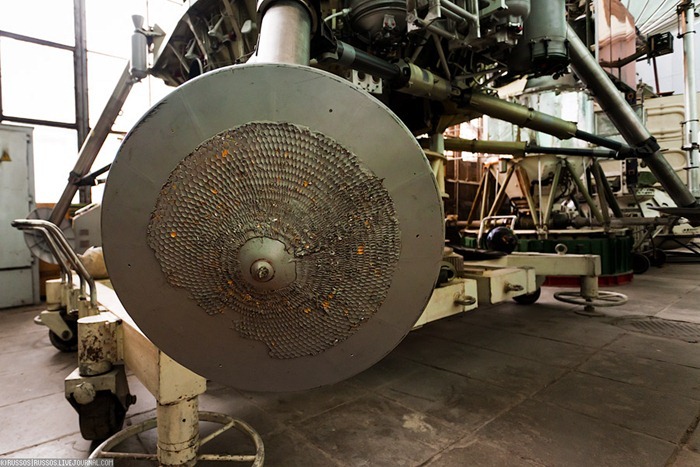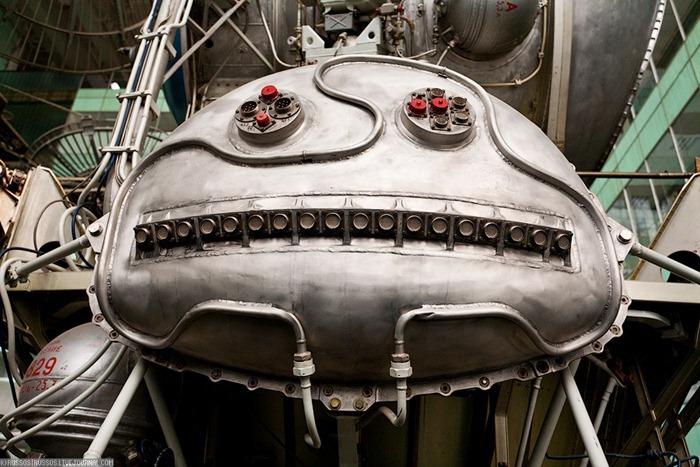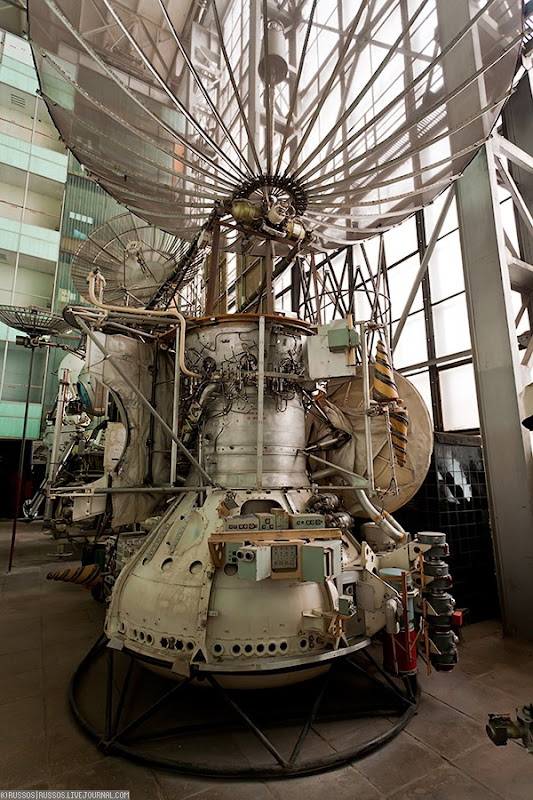After the United States beat the Russian’s in the race to the moon in the late 70s of the last century, the Soviet lunar program was covered up and forgotten. These rare photos are from a lab inside the Moscow Aviation Institute which still houses the spacecraft and the lunar lander that was supposed to take the first cosmonaut to the surface of the moon.
From Wired:
Soviet scientists were well ahead of their American counterparts in moon exploration before President John F. Kennedy pronounced the U.S. would put a man there first. The Soviets had already landed the probe Luna 2 on the surface of the moon in 1959 and had an orbiting satellite in 1966.
The Soviets developed a similar multi-step approach to NASA, involving a module used to orbit the moon and one for landing. Their version was decidedly less complex and lighter to account for inferior rockets. These photos show the LK “Lunar Craft” lander, which has a similar pod-over-landing gear structure but numerous key differences.
All the activities done by two astronauts is done by one. To make the craft lighter, the LK only fits the one cosmonaut, who was supposed to peer through a tiny window on the side of the craft to land it. After landing the vehicle the pod separates from the landing gear, as with the Apollo Lunar Module, but uses the same engine for landing as it does for take off as another weight savings.
The L2 Lunar Orbit Module designed to transport the LK into orbit around the moon was similarly stripped down. There’s no internal connection between the two craft so the cosmonaut had to space walk outside to get into the LK and head towards the surface. When the LK rejoined the L2 for the return trip home, the now likely exhausted would then climb back out into the abyss of space. The LK would then be thrown away.
There were numerous political, scientific and financial reasons why the Soviets didn’t make it to the moon first, including a space agency with split priorities and therefore not single-mindedly dedicated to this goal. Neil Armstrong walked on the moon first on July 20, 1969, besting the Russians, who were still planning to visit the moon in the upcoming years.
They had the equipment, but they didn’t have the rockets.
Getting to the moon requires launching a command module and a lander. Both are heavy objects and require massive amounts of thrust to get into orbit. The Soviet’s planned to use their N-1 rocket, but two failed launches in 1971 and 1972 destroyed dummy landing and control modules, as well as the rockets themselves, and led to the program being shelved for lack of a proper launch vehicle.
The LK was sent into space for numerous test missions. The first two unmanned flights were successful tests of the vehicle through a simulated orbit. The third flight ended when the N-1 rocket crashed. The fourth test in 1971 was a success, but years later the decaying test module started to return to Earth with a trajectory that would put it over the skies of Australia.
NASA explains in a report on the Soviet space program how they had to convince the Australians it wasn’t a nuclear satellite:
To allay fears of a nuclear catastrophe, representatives of the Soviet Foreign Ministry in Australia admitted that Cosmos 434 was an “experiment unit of a lunar cabin,” or lunar lander
Eventually, the program was deemed too expensive and unnecessary in light of the NASA success. The Soviets moved onto building space labs, successfully, and the remaining parts of the lunar program were destroyed or dispersed, including this amazing collection of parts hidden in the back of the Moscow Aviation Institute.
Apparently, students at the Moscow Aviation Institute are allowed access to this equipment, a Russian Livejournaler managed to get photos inside the lab that holds a lander, much of the docking equipment, and diagrams. The poster couldn’t show everything and describes the vibe around the many parts as secretive. Not all of the other pieces are easily identifiable as more than “satellite” or “Soyuz spacecraft” or “awesome and Soviet.”
Aandrogynous peripheral docking assembly
Pin on the expansion of needle
Some kind of engine. Judging from the size it is likely korrektiruyusche-brake motor
Lunar craft (LC)

Landing leg
Lunar craft (LC)

Porthole of the Lunar Lander

Some kind of spacecraft with large antennas
The hatch out of which the astronaut was supposed to climb into the lander
Open the hatch! Take the key
Photos: Livejournal




























And as in Russia, even a schoolboy knows that the Americans did not fly to the moon.
ReplyDeleteExcept we Americans did fly to the moon. And then we landed on it. And then Neil Armstrong walked on it. Why is it so hard for you fools to believe this? Especially when the evidence is still on the surface of the Moon.
Deleteyou lie. only sectarians say that. im russian. we not learn all american space history, but we not learn a lie. and we know about american landing on the moon
DeleteIt's so awesome how within the space of basically a year the Soviets went from being so far ahead of the American space program to being so ridiculously far behind. I mean yeah, how about those Americans aye - "remarkable". You just look at that lunar craft of the Soviets and you wonder if only they had made it out of tin foil and 2mm thick Aluminium pipe like the Americans did, what might have been...
ReplyDeleteSince Soviet space craft looked liked something built in a boiler works it's no wonder lifting capability was an issue. Regarding 'tin foil' and 2mm thick aluminum construction of the United States Lunar Lander, the design worked, and worked well from Apollo 11 through Apollo 17.
DeleteI'm always struck by the 'look' of the Soviet era equipment compared to the United States equipment. In comparison, Soviet era equipment always had that 'heavy industrial' 'nuts and bolts' appearance and looked more like assembled product from a 'boiler works' or tractor factory rather than aeronautical space craft. No disrespect intended as the former USSR had many space achievements..
ReplyDelete